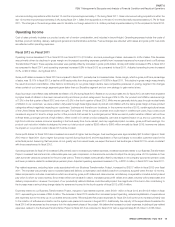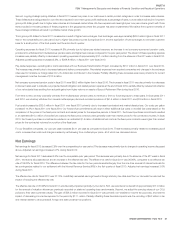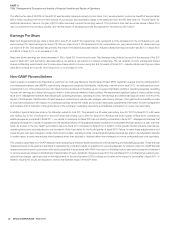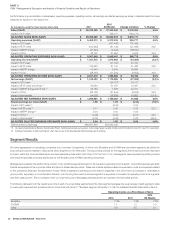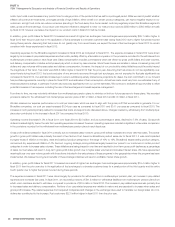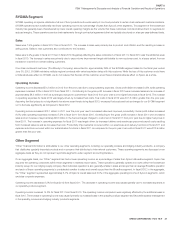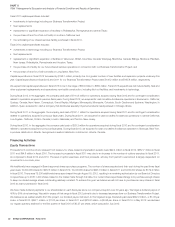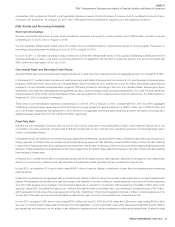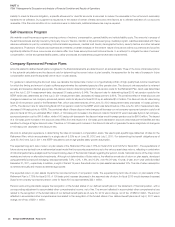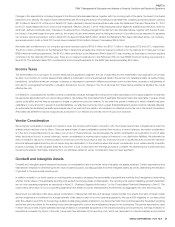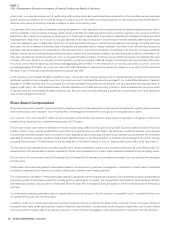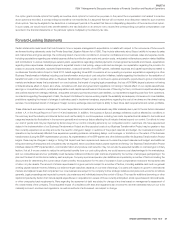Sysco 2012 Annual Report Download - page 50
Download and view the complete annual report
Please find page 50 of the 2012 Sysco annual report below. You can navigate through the pages in the report by either clicking on the pages listed below, or by using the keyword search tool below to find specific information within the annual report.SYSCO CORPORATION-Form10-K 27
PARTII
ITEM7Management’s Discussion and Analysis of Financial Condition and Results of Operations
SYGMA Segment
SYGMA operating companies distribute a full line of food products and a wide variety of non-food products to certain chain restaurant customer locations.
SYGMA operations have traditionally had lower operating income as a percentage of sales than Sysco’s other segments. This segment of the foodservice
industry has generally been characterized by lower overall operating margins as the volume that these customers command allows them to negotiate for
reduced margins. These operations service chain restaurants through contractual agreements that are typically structured on a fee per case delivered basis.
Sales
Sales were 7.4% greater in fi scal 2012 than in fi scal 2011. The increase in sales was primarily due to product cost infl ation and the resulting increase in
selling prices. Sales to new customers also contributed to the increase.
Sales were 9.2% greater in fi scal 2011 than in fi scal 2010. Negatively affecting the sales comparison of fi scal 2011 to fi scal 2010 was the additional week
in fi scal 2010. The increase in sales was primarily due to case volume improvement largely attributable to new customers and, to a lesser extent, from an
increase in volume from certain existing customers.
One chain restaurant customer (The Wendy’s Company) accounted for approximately 29% of the SYGMA segment sales for the fi scal year ended
June30,2012. SYGMA maintains multiple regional contracts with varied expiration dates with this customer. While the loss of this customer would have
a material adverse effect on SYGMA, we do not believe that the loss of this customer would have a material adverse effect on Sysco as a whole.
Operating Income
Operating income decreased $1.2million in 2012 from the prior year due to rising operating expenses. Gross profi t dollars increased 4.3% while operating
expenses increased 5.3% in fi scal 2012 from fi scal 2011. Contributing to the gross profi t increase in fi scal 2012 were increased sales and an increase of
approximately $8.3million in the fuel surcharges charged to customers in fi scal 2012 from prior year due to higher fuel prices in fi scal 2012. The increase
in operating expenses for fi scal 2012 was largely driven by increased fuel costs. Fuel costs in fi scal 2012 were $11.3million greater than the prior year.
Assuming that fuel prices do not signifi cantly rise above recent levels during fi scal 2013, we expect fuel costs and fuel surcharges for our SYGMA segment
not to fl uctuate signifi cantly as compared to fi scal 2012.
Operating income increased $13.1million in 2011 over the prior year due to increased sales and improved productivity. Gross profi t dollars increased
9.5% while operating expenses increased 7.2% in fi scal 2011 from fi scal 2010. Contributing to the gross profi t increase in fi scal 2011 were increased
sales and an increase of approximately $6.6million in the fuel surcharges charged to customers in fi scal 2011 from prior year due to higher fuel prices in
fi scal 2011. The increase in operating expenses for fi scal 2011 was largely driven by increased delivery and warehouse personnel payroll costs resulting
from increased sales as well as increased fuel cost. Productivity improvements occurred within our warehouse and delivery functions in fi scal 2011 and
expense reductions occurred within our administrative functions in fi scal 2011 as compared to the prior year. Fuel costs in fi scal 2011 were $12.9million
greater than the prior year.
Other Segment
“Other” fi nancial information is attributable to our other operating segments, including our specialty produce and lodging industry products, a company
that distributes specialty imported products and a company that distributes to international customers. These operating segments are discussed on an
aggregate basis as they do not represent reportable segments under segment accounting literature.
On an aggregate basis, our “Other” segment has had a lower operating income as a percentage of sales than Sysco’s Broadline segment. Sysco has
acquired the operating companies within these segments in relatively recent years. These operations generally operate in a niche within the foodservice
industry except for our lodging supply company. Each individual operation is also generally smaller in sales and scope than an average Broadline operation
and each of these operating segments is considerably smaller in sales and overall scope than the Broadline segment. In fi scal 2012, in the aggregate,
the “Other” segment represented approximately 5.7% of Sysco’s overall sales and 3.5% of the aggregate operating income of Sysco’s segments, which
excludes corporate expenses.
Operating income decreased 9.2% for fi scal 2012 from fi scal 2011. The decrease in operating income was caused partially due to increased expenses in
our specialty produce segment.
Operating income increased 14.3% for fi scal 2011 from fi scal 2010. The operating income comparison was negatively affected by the additional week in
fi scal 2010. The increase in operating income was caused primarily by increased sales in the specialty produce segment and favorable expense management
in the specialty produce and lodging industry products segments.




